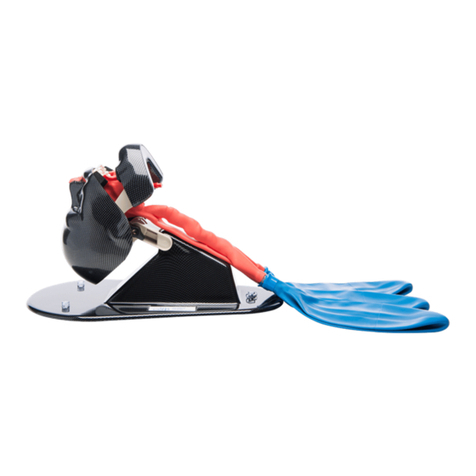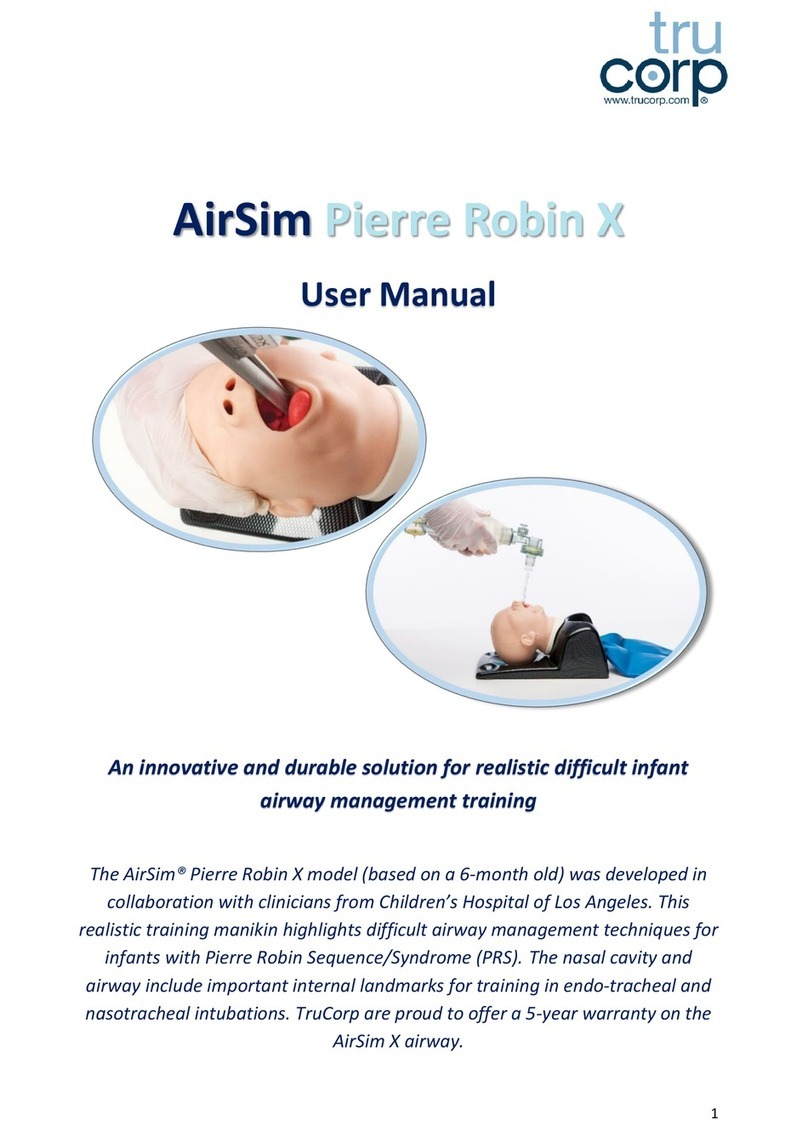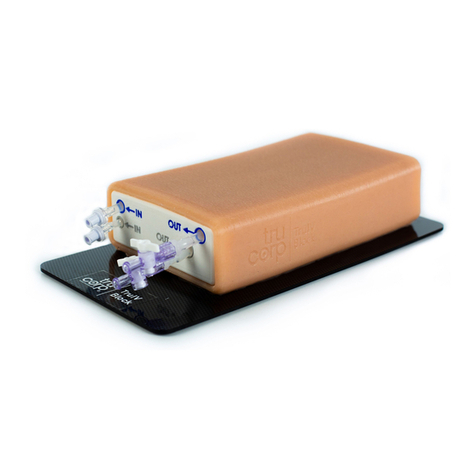TruCorp TruUltra TruPICC User manual

1
TruPICC
User Manual
Part of the TruUltra product range, TruPICC is an anatomical adult male arm
designed for teaching the skills associated with ultrasound guided PICC line and
Intravenous (IV) techniques.
TruPICC develops the user’s skills associated with needle placement, guidewires
and catheters. The upper arm anatomy features the brachial, basilic, cephalic
and median cubital veins, the superior vena cava and the brachial artery for
vessel differentiation.

2
Contents
Product specifications............................................................................................................................3
Package Contents...................................................................................................................................3
Recommended equipment sizes............................................................................................................3
Initial set-up information.......................................................................................................................4
Fluid system preparation .......................................................................................................................5
Re-filling the fluid system ......................................................................................................................7
IV cannulation ........................................................................................................................................7
PICC line..................................................................................................................................................8
Replacing the ultrasound insert.............................................................................................................9
Removing excess fluid from the system..............................................................................................11
Removing all fluid from the system.....................................................................................................14
FAQ and useful tips ..............................................................................................................................15
Care and Maintenance.........................................................................................................................16
Warranty...............................................................................................................................................16

3
Product specifications
Product Code: TPIC100
TruPICC weight: Approx. 6kg
TruPICC dimensions: 90 x 35 x 20cm
Full shipment weight: Approx. 8kg
Full shipment dimensions: 95 x 37 x 21cm
Package Contents
•1 TruPICC model (TPIC100)
•1 TruPICC carrier case
•1 USB pen drive user manual
•250ml bottle of artificial blood concentrate (CVB250)
•1 luer lock syringe
Recommended equipment sizes
•Size 20G needle for IV cannulation is recommended for optimal performance. Do not use
a needle larger than 18G
•Size 4F PICC catheter with soft tip guidewire, single lumen, and approx. 55-60cm length
•Using equipment sizes outside of TruCorp’s recommendations can cause permanent
damage to the model and the product warranty will be void (please refer to page 16 for
warranty information)

4
Initial set-up information
1. Gently remove the model from the carrier case and place on a suitable flat surface
2. In line with clinical guidelines, ultrasound gel should be applied to the ultrasound probe
prior to use to ensure a high-quality ultrasound image is obtained
3. Any brand of ultrasound machine can be used with this model. Adjust the depth and gain
controls as required until the desired image is obtained
4. Needle penetration can be performed on the interchangeable ultrasound insert on the
upper arm only. If damage occurs from needle penetration on other parts of the model,
the product warranty will be void (please refer to page 16 for warranty information)
Needle penetration should only be carried within the area highlighted in red above (excluding the artery)

5
Fluid system preparation
1. Mix the required concentration of the artificial blood supplied with the model (product
code: CVB250) as indicated on the bottle’s instructions (ratio of blood to water is 1:9).
Distilled water can be used as a substitute for blood if desired
2. Fill the syringe and switch the ‘CEPHALIC’ vein network to ‘ON’ to allow blood to be
inserted into the cephalic vein:
3. Attach the blood-filled syringe to the connection point and slowly insert 60ml, ensuring
the syringe does not contain air bubbles. Air bubbles will negatively impact upon the
ultrasound image obtained:

6
4. Switch the ‘CEPHALIC’ vein network to ‘OFF,’ before switching the ‘BASILIC’ vein network
to ‘ON’ to allow blood to be inserted into the basilic vein:
5. Re-fill the syringe with blood as required and slowly insert 60ml, ensuring the syringe
does not contain air bubbles. Air bubbles will negatively impact upon the ultrasound
image obtained:
6. Switch the ‘BASILIC’ vein network to ‘OFF’
7. The basilic artery is pre-filled –you do not need to insert blood to the artery. Please do
not penetrate the artery. If damage occurs from needle penetration on the artery, the
product warranty will be void (please refer to page 16 for warranty information)
8. The purpose of the artery is to differentiate it from the veins –it will not be collapsible
like a vein

7
Re-filling the fluid system
1. Users can remove fluid through the syringe after the veins have been cannulated to
confirm correct needle placement. Please note that the volume of fluid previously
withdrawn will need to be refilled to maintain a high-quality ultrasound image for
further training
2. Follow steps 1-5 in the fluid system preparation section (please refer to page 5) to
slowly re-fill approx. 15-20ml of blood into the veins (may be higher than 15-20ml
depending on the previous volume of blood withdrawn)
3. Blood can be inserted directly back into the veins after withdrawal if desired. This will
not cause damage to the veins, but please ensure to avoid injecting blood with air
bubbles as this will have a negative impact on the image quality. Blood should be
inserted slowly
IV cannulation
1. In line with clinical guidelines, ultrasound gel should be applied to the ultrasound probe
prior to use to ensure a high-quality ultrasound image is obtained
2. IV cannulation can be performed using the median cubital, brachial or basilic veins
3. A 20G needle should be used for IV techniques for optimal performance. Using a needle
larger than 18G will void the warranty if damage is caused to the model (please refer to
page 16 for warranty information)
4. Correct needle placement can be visually confirmed by attaching a syringe to the needle
and withdrawing blood

8
PICC line
1. In line with clinical guidelines, ultrasound gel should be applied to the ultrasound probe
prior to use to ensure a high-quality ultrasound image is obtained
2. PICC line can be performed using the basilic or cephalic veins
3. A 20G needle should be used to gain access to the vein, followed by a size 4F PICC catheter
(with soft tip guidewire, single lumen, and approx. 55-60cm length)
4. Using equipment larger than the above recommendations will void the warranty if
damage is caused to the model (please refer to page 16 for warranty information)
5. Correct needle placement for IV can be visually confirmed by attaching a syringe to the
needle and withdrawing blood
6. Additionally, a successful PICC line can be confirmed by using ultrasound on the superior
vena cave to confirm the catheter placement

9
Replacing the ultrasound insert
1. Gently pull back the skin at the side of the insert (closest to the product’s shoulder) and
remove the large pin:
2. Press the metal studs to loosen the insert:

10
3. Gently remove the insert from the model and discard:
4. Align a new insert correctly into position and perform the reverse of steps 1-3 (starting
with step 3) as above. Please ensure all connectors are securely placed:

11
Removing excess fluid from the system
When the fluid container reaches ‘MAX’level, it is necessary to empty the blood:
1. Open the latch:
2. Loosen the screws on both sides of the container:

12
3. Gently remove the container and disconnect the tube by pressing the metal studs:
4. Remove the plug from the area indicated below:
5. Empty the container (approx. 1 litre of fluid when full):

13
6. When the container is empty, perform the reverse of steps 2-5 (starting with step 5) as
above. Please ensure all connectors are securely placed:

14
Removing all fluid from the system
This is recommended when the model is being transported, or kept in storage for
extended periods of time (keeping fluid in the system short-term will not damage the
model)
1. Switch the ‘CEPHALIC’ vein network to ‘ON’ to remove blood from the cephalic vein and
connect an air-filled syringe to the connection (please disregard the blood in the syringe
shown below, the syringe should contain air only for removal of fluid):
2. Keep pushing air through the vein until no more blood can be drained
3. Switch the ‘CEPHALIC’ vein network to ‘OFF,’ before switching the ‘BASILIC’ vein network
to ‘ON’ to remove blood from the basilic vein:
4. Repeat step 2 as above, until no more blood can be drained from the model
5. Switch the ‘BASILIC’ vein network to ‘OFF’
6. Please refer to page 11 to remove the fluid that has been drained, which will have
emptied into the excess fluid container

15
FAQ and useful tips
1. Why can’t I visualise the veins clearly? Poor quality ultrasound images are caused by air
inside the blood. To improve the image, insert more blood into the cephalic and basilic
veins (please refer to the fluid system preparation on page 5). Approx. 10-20ml per vein
should be sufficient
2. How often do I need to replace the ultrasound insert? The ultrasound insert
comfortably facilitates 800+ needle penetrations using the recommended equipment
sizes (please refer to page 3). You can close one side of the fluid system when it is
destroyed by switching the appropriate vein to ‘OFF’ (please refer to the fluid system
preparation on page 5). The functioning side of the insert can still be used as normal
without leaks from the used side
3. Why is the insert leaking when I refill blood into the veins? Sometimes when refilling
blood into the system, you may see some small leaks on the insert from old punctures.
This is caused when the blood is being refilled too quickly through the syringe. To
minimize the leakage, enter the fluid slowly
Image on left shows air bubbles negatively impacting image quality; image on right shows high
quality image after more blood has been inserted

16
Care and Maintenance
Store the product in clean, dry conditions away from heat and direct sunlight; avoid contact
with metals, solvents, oils or greases and strong detergents. When the product is not in use
please store in the black carrier case provided.
Gently wash the ultrasound insert after use. Please use alcohol wipes, warm soapy water or
similar, until all visible foreign matter and residue are removed.
Mild detergents or enzymatic cleaning agents may be used on the insert in accordance with
the manufacturer's instructions and at the proper dilution. The detergent must not contain
skin or mucous membrane irritants.
Please do not use any of the following when cleaning the TruUltra product range:
•Germicides, disinfectants, or chemical agents such as glutaraldehyde (e.g. Cidex®)
•Ethylene oxide, phenol-based cleaners or iodine-containing cleaners
In response to the recent COVID-19 pandemic, we recommend this additional step to ensure
the product is fully sanitised:
Use alcohol spray (minimum 75%) and wipe off. Repeat this for 3-4 times to ensure to kill
the virus completely.
Warranty
TruCorp warrants this unit to be free of defects in materials and workmanship and to give
satisfactory service for a period of 1-year from the date of delivery. This ensures that our
customers receive maximum coverage on each product. If the unit should malfunction it must
be returned to the factory for evaluation. Upon examination by TruCorp, if the unit is found
to be defective it will be repaired or replaced at no charge.
TruCorp will pay for the freight/delivery and the actual parts needed free of charge if any part
of the product fails within the 1-year period.
However, these warranties are VOID, if; the unit shows evidence of having been tampered
with or shows evidence of having been damaged by excessive heat, the use of sharp
instruments, misapplication, misuse or other operating conditions outside of TruCorp’s

17
control. Additionally, penetration of a needle into the artery will cause internal damage and
will not be covered by warranty if this area leaks. Please ensure you closely follow the
recommended equipment sizes, otherwise your warranty will be void if damage is inflicted on
the model (please refer to page 3 for recommended equipment sizes). Components that wear
or are damaged by misuse are not warranted and will be charged for, if a repair has been
approved. Warranty is void if third party products are seen to have damaged or caused the
failure of the TruCorp models.
Please direct all warranty and repair requests/inquiries to:
TruCorp Ltd
33 Waringstown Road
Lurgan, Co. Armagh
BT667HH
N. Ireland
Tel: +44 (0) 28 3888 2714
This manual suits for next models
1
Table of contents
Other TruCorp Medical Equipment manuals
Popular Medical Equipment manuals by other brands

Getinge
Getinge Arjohuntleigh Nimbus 3 Professional Instructions for use

Mettler Electronics
Mettler Electronics Sonicator 730 Maintenance manual

Pressalit Care
Pressalit Care R1100 Mounting instruction

Denas MS
Denas MS DENAS-T operating manual

bort medical
bort medical ActiveColor quick guide

AccuVein
AccuVein AV400 user manual














